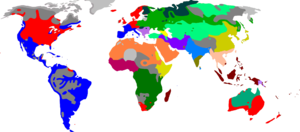Interslavic
| Interslavic | |
|---|---|
| Меджусловjaнски | |
 | |
| Writing | w:Cyrillic script |
| Region: | w:Slavisphere |
| Genders: | 3 |
| Cases: | 6 |
| Alignment | Nominative-Accusative |
| Proto-language: | w:Proto-Slavic |
| Typology: | Fusional |
| Word-Order | SVO |
| Languages: | w:Belarusian language,
w:Russian language, w:Ukrainian language w:Czech language w:Slovak language w:Polish language |
| Population: | 300 million |
 | |
|
Africa: SEDES • Middle Semitic • Kintu • Guosa Central Asia: Jalpi • Caucas • Zens • Dravindian • Neo-Sanskrit Europe: Intralingua • Folksprak • Interslavic • Balkan • Samboka Far East: Dan'a'yo • IM • MSEAL | |
Anthropology
More than almost any other Universal Language, Slavs have a pre-existing unity, and indeed were a common language 1,000 years ago, known as w:Common Slavic and later w:Old Church Slavonic. It is a well documented fact that the Slavic languages have fractured into three families: Eastern, Western, and Southern. Our procedure is to consider the contributions of the Eastern languages as one vote in vocabulary, since they are almost mutually intelligible and they have won the orthography battle. Czech and Slovak are broadly similar. Polish (and Silesian) have diverged quite radically (and no one else has retroflex consonants, so those are excluded). Sorbian is not even really unified, with Upper and Lower being exceedingly different from each other.
The following languages, as well as w:Proto-Slavic are consulted at every stage.
- Czech, Slovakian
- Polish (and Silesian)
- Sorbian
- Russian, Belarusian, Ukrainian, Rusyn
Southern Slavic may be consulted, but doesn't vote, because it votes in Balkan.
Phonology
Vowels
Interslavic has the five cardinal vowels (a e i o u) and the near-high, front vowel /ɪ/. /ɑ/ should be just /a/. /ə/ can be just /ɛ/. There also syllabic /r/, which can be prepended with a schwa as needed for no difference.
Consonants
- Nasal: m, n, ñ
- Stops: p, t, k, b, d, g
- Fricatives: f, s, š, h, v, z, ž
- Affricates: ts, tš, dz, dž
- Trill: r
- liquids: l~ɫ, j, ʎ~lʲ
There are no other palatalized consonants
Phonotactics
- Hard: the labials p b f v m, the alveolars t d s z n r l and the velars k g h
- Soft: the postalveolars š ž č dž, the affricates c dz, and j
/ɪ/ can only occur after a hard, but never after a velar
Palatalization
Palatalization means that under certain circumstances the velar consonants k g h are changed to the postalveolar consonants č ž š. This happens when they are followed by an ending with -e-, -i- or -j-, as well as before the prefixes -ny, -ski, -nik, -stvo, -ok, -ka, -ko. For example: mog- + -eš > možeš, ruk- + -ny > ručny, muh- + ka > muška.
Softening
Softening is the process of adding a [ʲ] to a consonant, resulting in a more palatal pronunciation. The number of soft consonants in the phoneme inventory varies greatly from one language to another. In Interslavic only two soft consonants are obligatory: ʎ and ñ.
Iotation
- The combinations s+j and z+j become š ž.
- The velars k g h, when followed by j, palatalize into č ž š.
- In the sequences sk st zg zd, the s and z are iotated along with the following consonant
- š ž č j simply swallow the following j.
Orthography
Six vowels = The Big 5 + /ɪ~ɨ/, p/t/k, b/d/g, f/s/š, h~x, v/z/ž, c/č, dz/dž, m/n/ñ, r, l~ʎ, j
Russian comparison
- Vowel Letters
- Аа
ЁёИи (=i) Оо Уу (=u) Ыы (=y) Ээ (=e) - Consonantal Letters
- Бб (=b) Вв (=v) Гг Дд Жж (=ž) Зз (=z) Кк Йй (=j) Лл (=l) Мм Нн (=n) Пп Рр Сс (=s) Тт Фф Хх Цц Чч (=č) Шш (=š)
Щщ - Other
ЪъЬь- Ligatures
- Ее=je Юю=ju Яя=ja Њњ=nj
- Digraphs
- ДЗ/дз ДЖ/дж
Morphology
3 genders, 2 numbers, six cases. Adjectives agree in gender, number, and case. The o/e y/i rule
| Full | Short | |
|---|---|---|
| Nom. | Я | Я |
| Acc. | Мзнз | Мз |
| Gen. | Мзнз | Мзнз |
| Dat. | Мнз | Ми |
| Ins. | Мною | Мною |
| Loc. | Мнз | Мнз |
Morphosyntax
Word order is almost free, but most often SVO. Modifiers precede nouns, generally.
Lexicography
- кава - coffee